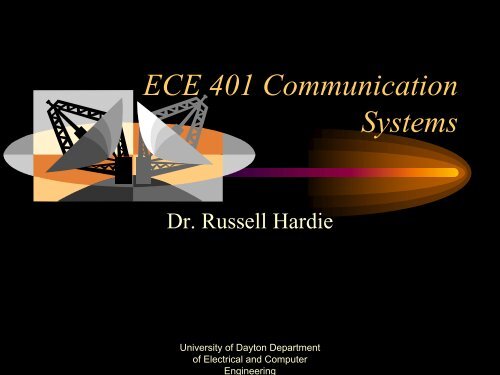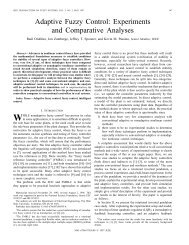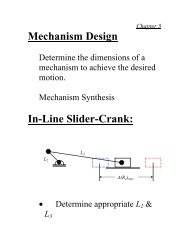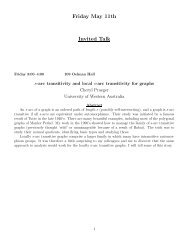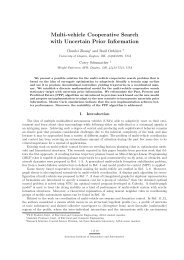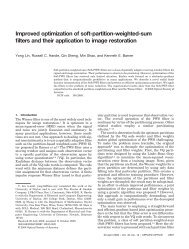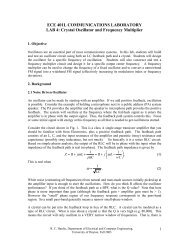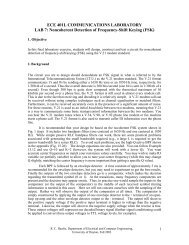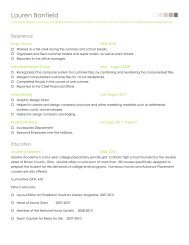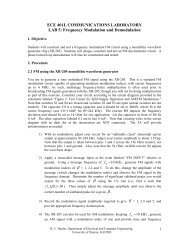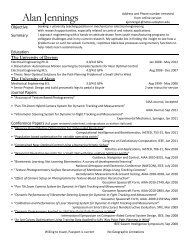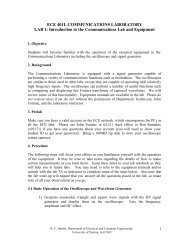ECE 401 Communication Systems - University of Dayton : Homepages
ECE 401 Communication Systems - University of Dayton : Homepages
ECE 401 Communication Systems - University of Dayton : Homepages
You also want an ePaper? Increase the reach of your titles
YUMPU automatically turns print PDFs into web optimized ePapers that Google loves.
<strong>ECE</strong> <strong>401</strong> <strong>Communication</strong><br />
Dr. Russell Hardie<br />
<strong>University</strong> <strong>of</strong> <strong>Dayton</strong> Department<br />
<strong>of</strong> Electrical and Computer<br />
Engineering<br />
<strong>Systems</strong>
• Syllabus<br />
• Historical perspective<br />
• Anatomy <strong>of</strong> a communication system<br />
• Analog vs. digital communications<br />
• Types <strong>of</strong> channels<br />
<strong>University</strong> <strong>of</strong> <strong>Dayton</strong> Department<br />
<strong>of</strong> Electrical and Computer<br />
Engineering<br />
Outline
Focus on EM Signals<br />
• Nearly all long distance modern communications<br />
uses electro-magnetic (EM) signals<br />
• EM signals may be in guided wireline channels<br />
(twisted pair, coaxial, or optic fiber) or wireless<br />
channels (free space)<br />
• Relatively easy to generate, detect, manipulate,<br />
amplifiy, etc.<br />
• Travel at or near the speed <strong>of</strong> light<br />
• Notable exception is underwater acoustic channels<br />
<strong>University</strong> <strong>of</strong> <strong>Dayton</strong> Department<br />
<strong>of</strong> Electrical and Computer<br />
Engineering
1837<br />
Samuel Morse<br />
Electric Telegraph<br />
Balt-Wash 1844<br />
Historical Perspective<br />
(EM Wireline Telecommunications)<br />
1858 1876 1915 1953 1960<br />
Trans-Atlantic<br />
Telegraph<br />
Alexander Bell<br />
Telephone<br />
Hundred Miles<br />
Transcontinental<br />
Telephone<br />
Thanks to<br />
Triode Amplifier<br />
<strong>University</strong> <strong>of</strong> <strong>Dayton</strong> Department<br />
<strong>of</strong> Electrical and Computer<br />
Engineering<br />
Trans-Atlantic<br />
Telephone<br />
First<br />
Electronic<br />
Switch<br />
Thanks to<br />
Transistor
More Recent Advances<br />
(EM Wireline Telecommunications)<br />
• Digital transmission <strong>of</strong> voice, video, and<br />
data for more reliable communications<br />
• Move to fiber optic cables yielding a<br />
massive bandwidth increase<br />
<strong>University</strong> <strong>of</strong> <strong>Dayton</strong> Department<br />
<strong>of</strong> Electrical and Computer<br />
Engineering
Here for more<br />
1831<br />
Michael Faraday<br />
Current Produced<br />
When Moving<br />
A Magnet Near<br />
Conductor*<br />
1894<br />
Oliver Lodge<br />
Develops<br />
Sensitive RF<br />
Detector<br />
150 yds<br />
Historical Perspective<br />
(EM Wireless Telecommunications)<br />
1901<br />
Marconi<br />
Transmits<br />
1700 Miles<br />
<strong>University</strong> <strong>of</strong> <strong>Dayton</strong> Department<br />
<strong>of</strong> Electrical and Computer<br />
Engineering<br />
1936 1965<br />
1920 1933 1962<br />
AM<br />
Broadcasts<br />
FM<br />
Broadcasts<br />
BBC Transmits<br />
TV<br />
* M. Guillen Five Equations That Changed the World, MJF Books, New York<br />
Satellite<br />
Relays TV<br />
US-Europe<br />
Commercial<br />
Satellite<br />
Comm.
1920 Spark Transmitter<br />
<strong>University</strong> <strong>of</strong> <strong>Dayton</strong> Department<br />
<strong>of</strong> Electrical and Computer<br />
Engineering
More Recent Advances<br />
(EM Wireless Telecommunications)<br />
• Digital transmission <strong>of</strong> voice, video, and<br />
data for more reliable communications<br />
• Satellite communications<br />
• Cell phones<br />
• Wireless LAN<br />
<strong>University</strong> <strong>of</strong> <strong>Dayton</strong> Department<br />
<strong>of</strong> Electrical and Computer<br />
Engineering
Information<br />
Source<br />
Received<br />
Information<br />
Anatomy <strong>of</strong> a <strong>Communication</strong><br />
Transmitter<br />
Receiver<br />
<strong>University</strong> <strong>of</strong> <strong>Dayton</strong> Department<br />
<strong>of</strong> Electrical and Computer<br />
Engineering<br />
System<br />
Transmission<br />
Medium<br />
(Channel)
Analog <strong>Communication</strong>s<br />
• Analog Signal: Continuous in time and value<br />
• Analog communications: The channel carries<br />
analog information<br />
• Note DSP may be used in parts <strong>of</strong> the transmitter<br />
and/or receiver, but the information content <strong>of</strong> the<br />
signal passed through the channel is analog<br />
<strong>University</strong> <strong>of</strong> <strong>Dayton</strong> Department<br />
<strong>of</strong> Electrical and Computer<br />
Engineering
Digital <strong>Communication</strong>s<br />
• Digital Signal: Discrete in time and value<br />
• Digital Information: Sequence <strong>of</strong> symbols from a<br />
finite set<br />
• Digital communications: The channel carries digital<br />
information<br />
• Note that the waveforms transmitted through the<br />
channel are analog, but the information content <strong>of</strong><br />
those waveforms is digital.<br />
• Also note that some analog electronics may be<br />
involved in the transmitter and receiver<br />
<strong>University</strong> <strong>of</strong> <strong>Dayton</strong> Department<br />
<strong>of</strong> Electrical and Computer<br />
Engineering
Information<br />
Source<br />
Received<br />
Information<br />
Analog <strong>Communication</strong> System<br />
Transducer<br />
Transducer<br />
Transmitter<br />
Receiver<br />
CW<br />
Modulation*<br />
CW<br />
Demodulation*<br />
<strong>University</strong> <strong>of</strong> <strong>Dayton</strong> Department<br />
<strong>of</strong> Electrical and Computer<br />
Engineering<br />
Transmission<br />
Medium<br />
(Channel)<br />
* Not Required for<br />
Baseband Transmission.<br />
CW = Continuous Wave
Analog <strong>Communication</strong>s<br />
• Transducer converts the energy from the<br />
original information source into a suitable<br />
electrical signal (e.g., microphone).<br />
• Continuous wave (CW) modulation shifts<br />
the frequency content <strong>of</strong> the signal into a<br />
desired range for a given channel.<br />
<strong>University</strong> <strong>of</strong> <strong>Dayton</strong> Department<br />
<strong>of</strong> Electrical and Computer<br />
Engineering
Acoustic Speech<br />
Signal<br />
Information<br />
Source<br />
Analog Comm. Sys. Example<br />
Amplitude Modulation (AM)<br />
v(t)<br />
300<br />
250<br />
200<br />
150<br />
100<br />
50<br />
0<br />
50 100 150 200 250<br />
t<br />
300 350 400 450 500<br />
Transducer<br />
<strong>University</strong> <strong>of</strong> <strong>Dayton</strong> Department<br />
<strong>of</strong> Electrical and Computer<br />
Engineering<br />
v(t)<br />
300<br />
200<br />
100<br />
0<br />
-100<br />
-200<br />
Transmitter<br />
50 100 150 200 250<br />
t<br />
300 350 400 450 500<br />
CW<br />
Modulation<br />
Antenna
¼-wavelength monopole<br />
Virtual ¼-wavelength monopole<br />
reflected through the ground plane<br />
Antenna Example<br />
(1/2 Wavelength Dipole)<br />
λ /4<br />
λ /4<br />
<strong>University</strong> <strong>of</strong> <strong>Dayton</strong> Department<br />
<strong>of</strong> Electrical and Computer<br />
Engineering<br />
λ =<br />
Ground plane<br />
c<br />
f<br />
Propagation velocity<br />
Freq <strong>of</strong> time-variation
• Speech 300-3600 Hz<br />
• CD Music 20-20 kHz<br />
• Video 0-4 MHz<br />
Baseband Signals<br />
<strong>University</strong> <strong>of</strong> <strong>Dayton</strong> Department<br />
<strong>of</strong> Electrical and Computer<br />
Engineering<br />
8<br />
3× 10 m/s<br />
λ = = 166,667 m/c<br />
1800 Hz (c/s)<br />
λ / 4 = 41,667 m/c<br />
8<br />
3× 10 m/s<br />
λ = =<br />
10,000 Hz (c/s)<br />
λ / 4=7,500 m/c<br />
8<br />
3× 10 m/s<br />
6<br />
2× 10 Hz (c/s)<br />
30,000 m/c<br />
λ = = 150 m/c<br />
λ / 4=37.5 m/c
Need for Radio Frequency (RF)<br />
• To directly transmit most baseband signals, via<br />
EM propagation, the antenna dimensions would be<br />
wildly impractical!<br />
• The modulator allows us to modify (modulate) an<br />
RF signal in proportion to the message.<br />
• The RF carrier is <strong>of</strong> high enough frequency to<br />
allow for practical antenna dimensions for a given<br />
application.<br />
• The message signal can be recovered from the<br />
modulated RF carrier at the receiver using<br />
demodulation.<br />
<strong>University</strong> <strong>of</strong> <strong>Dayton</strong> Department<br />
<strong>of</strong> Electrical and Computer<br />
Engineering
Commercial Broadcast FM<br />
• 100 bands each 200 kHz wide centered at<br />
88.1, 88.3, 88.5, … 107.9 MHz<br />
8<br />
3× 10 m/s<br />
6<br />
97.5× 10 Hz (c/s)<br />
λ = =<br />
λ / 4=0.77 m/c (30 in)<br />
<strong>University</strong> <strong>of</strong> <strong>Dayton</strong> Department<br />
<strong>of</strong> Electrical and Computer<br />
Engineering<br />
3.08 m/c
Commercial Broadcast TV &<br />
• VHF:<br />
– Channels 2-4: 54-72 MHz<br />
– Channels 5-6: 76-88 MHz<br />
– Channels 7-13: 174-216 MHz<br />
• UHF:<br />
– Channels 14-83: 470-890 MHz<br />
– Channels 70-83 (806-890 MHz) is allocated for cell phones<br />
• ¼-Wave Antenna Dimension Examples<br />
– Channel 5 ¼-wave antenna = 38 in<br />
– Channel 13 ¼-wave antenna = 14 in<br />
– Channel 30 ¼-wave antenna = 5 in<br />
– Mobile phone 859 MHz ¼-wave antenna = 3.4 in<br />
<strong>University</strong> <strong>of</strong> <strong>Dayton</strong> Department<br />
<strong>of</strong> Electrical and Computer<br />
Engineering<br />
Cell Phone
Continuous Wave Modulation<br />
Amplitude<br />
Modulation (AM)<br />
mt ()<br />
xt () = Amt () cos(2πf<br />
t + θ )<br />
mt ()<br />
mt<br />
()<br />
Frequency<br />
Modulation (FM)<br />
Phase<br />
Modulation (PM)<br />
<strong>University</strong> <strong>of</strong> <strong>Dayton</strong> Department<br />
<strong>of</strong> Electrical and Computer<br />
Engineering<br />
c c c<br />
xt () = Acos( 2πf t+ 2 π f m(<br />
τ ) dτ<br />
+ θ )<br />
c c d c<br />
τ = 0<br />
xt () = Acos(2 π ft+ k m()<br />
t + θ )<br />
c c p c<br />
t<br />
∫
CW Modulation<br />
v(t)<br />
Message @ baseband<br />
1<br />
0.8<br />
0.6<br />
0.4<br />
0.2<br />
0<br />
-0.2<br />
-0.4<br />
-0.6<br />
-0.8<br />
-1<br />
0 0.1 0.2 0.3 0.4 0.5<br />
t<br />
0.6 0.7 0.8 0.9 1<br />
AM<br />
FM<br />
PM<br />
<strong>University</strong> <strong>of</strong> <strong>Dayton</strong> Department<br />
<strong>of</strong> Electrical and Computer<br />
Engineering<br />
v(t)<br />
v(t)<br />
v(t)<br />
2<br />
1.5<br />
1<br />
0.5<br />
0<br />
-0.5<br />
-1<br />
-1.5<br />
1<br />
0.8<br />
0.6<br />
0.4<br />
0.2<br />
0<br />
-0.2<br />
-0.4<br />
-0.6<br />
-0.8<br />
Amplitude Modulation (AM)<br />
0 0.1 0.2 0.3 0.4 0.5<br />
t<br />
0.6 0.7 0.8 0.9 1<br />
Frequency Modulation (FM)<br />
-1<br />
0 0.1 0.2 0.3 0.4 0.5<br />
t<br />
0.6 0.7 0.8 0.9 1<br />
1<br />
0.8<br />
0.6<br />
0.4<br />
0.2<br />
0<br />
-0.2<br />
-0.4<br />
-0.6<br />
-0.8<br />
Phase Modulation (PM)<br />
-1<br />
0 0.1 0.2 0.3 0.4 0.5<br />
t<br />
0.6 0.7 0.8 0.9 1
Information<br />
Source<br />
Received<br />
Information<br />
Digital <strong>Communication</strong> System<br />
Source & Channel<br />
Encoder<br />
Transmitter<br />
Digital<br />
Modulation*<br />
Codec Modem<br />
Source & Channel<br />
Decoder<br />
Receiver<br />
Digital<br />
Demodulation*<br />
<strong>University</strong> <strong>of</strong> <strong>Dayton</strong> Department<br />
<strong>of</strong> Electrical and Computer<br />
Engineering<br />
Transmission<br />
Medium<br />
(Channel)<br />
* May not be<br />
required<br />
for simple<br />
baseband<br />
transmission
Digital <strong>Communication</strong>s<br />
• Source coding involved coding the desired<br />
information into a finite symbol set (preferably in<br />
an efficient manner).<br />
• Channel coding involves adding systematic<br />
redundancy so that error in transmission can be<br />
detected and corrected.<br />
• Digital modulation generates a specific waveform<br />
(suitable for the given channel) for each symbol to<br />
be transmitted.<br />
<strong>University</strong> <strong>of</strong> <strong>Dayton</strong> Department<br />
<strong>of</strong> Electrical and Computer<br />
Engineering
Acoustic<br />
Speech<br />
Signal<br />
v(t)<br />
300<br />
250<br />
200<br />
150<br />
100<br />
50<br />
0<br />
Information<br />
Source<br />
Digital Comm. Sys. Example<br />
50 100 150 200 250<br />
t<br />
300 350 400 450 500<br />
Transmitter<br />
Source & Channel<br />
Encoder<br />
v(t)<br />
5<br />
4.5<br />
4<br />
3.5<br />
3<br />
2.5<br />
2<br />
1.5<br />
1<br />
0.5<br />
1<br />
111 0 0 0 00<br />
0<br />
0 50 100 150<br />
t<br />
200 250 300<br />
<strong>University</strong> <strong>of</strong> <strong>Dayton</strong> Department<br />
<strong>of</strong> Electrical and Computer<br />
Engineering<br />
Frequency Shift Keying (FSK)<br />
1<br />
v(t)<br />
0.8<br />
0.6<br />
0.4<br />
0.2<br />
-0.2<br />
-0.4<br />
-0.6<br />
-0.8<br />
Digital<br />
Modulation<br />
1<br />
0<br />
-1<br />
0 50 100 150<br />
t<br />
200 250 300<br />
Antenna
Digital Modulation<br />
• One waveform is transmitted for each symbol<br />
from a finite set.<br />
• Lowpass channel signaling with baseband signals<br />
– Pulse Modulation<br />
– Custom Orthogonal Waveforms<br />
• Bandpass channel signaling using carrier<br />
modulation<br />
– ASK, PSK, FSK<br />
– QAM<br />
– And many more…<br />
<strong>University</strong> <strong>of</strong> <strong>Dayton</strong> Department<br />
<strong>of</strong> Electrical and Computer<br />
Engineering
EM <strong>Communication</strong> System<br />
EM <strong>Communication</strong> <strong>Systems</strong><br />
Analog Comm Digital Comm<br />
<strong>University</strong> <strong>of</strong> <strong>Dayton</strong> Department<br />
<strong>of</strong> Electrical and Computer<br />
Engineering<br />
Categories<br />
Wireless Wireline Wireless Wireline<br />
Radio (AM, FM)<br />
Broadcast TV (UHF, VHF)<br />
Analog Cell Phones<br />
Long Distance Phone (microwave)<br />
Local Phone<br />
Cable TV<br />
Digital Cell Phones<br />
Wireless LAN<br />
Satellite Phone<br />
Satellite TV<br />
Long Distance Phone (microwave)<br />
Phone/Cable Modem<br />
Digital Cable TV<br />
Fiber Optic<br />
Ethernet<br />
Long Distance Phone
• EM Wireline<br />
– Wire<br />
– Twisted pair<br />
– Coaxial<br />
– Fiber Optic<br />
• EM Wireless<br />
– Free space<br />
<strong>Communication</strong>s Channels<br />
• Storage<br />
<strong>University</strong> <strong>of</strong> <strong>Dayton</strong> Department<br />
<strong>of</strong> Electrical and Computer<br />
Engineering<br />
– Optical (CD)<br />
– Magnetic, etc.<br />
• Acoustic<br />
– Air (short range only)<br />
– Water<br />
• Seismic<br />
– Earth
• Noise power<br />
• Signal power<br />
• Bandwidth<br />
xt<br />
()<br />
LTI System<br />
h(t)<br />
<strong>University</strong> <strong>of</strong> <strong>Dayton</strong> Department<br />
<strong>of</strong> Electrical and Computer<br />
Engineering<br />
Channel Issues<br />
• Fidelity (analog)<br />
• Data rate & probability<br />
<strong>of</strong> error (digital)<br />
∑<br />
nt ()<br />
y() t = x()* t h() t + n() t
• Hartley-Shannon Theorem<br />
(band-limited channel with<br />
additive white noise)<br />
C = Blog (1 +<br />
S/ N)<br />
2<br />
Channel Capacity<br />
Capacity (bps)<br />
7000<br />
6000<br />
5000<br />
4000<br />
3000<br />
2000<br />
1000<br />
0<br />
100<br />
<strong>University</strong> <strong>of</strong> <strong>Dayton</strong> Department<br />
<strong>of</strong> Electrical and Computer<br />
Engineering<br />
80<br />
60<br />
SNR<br />
40<br />
20<br />
0<br />
0<br />
200<br />
400<br />
600<br />
Bandwidth (Hz)<br />
800<br />
1000


